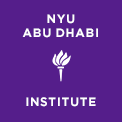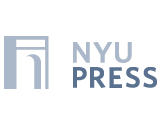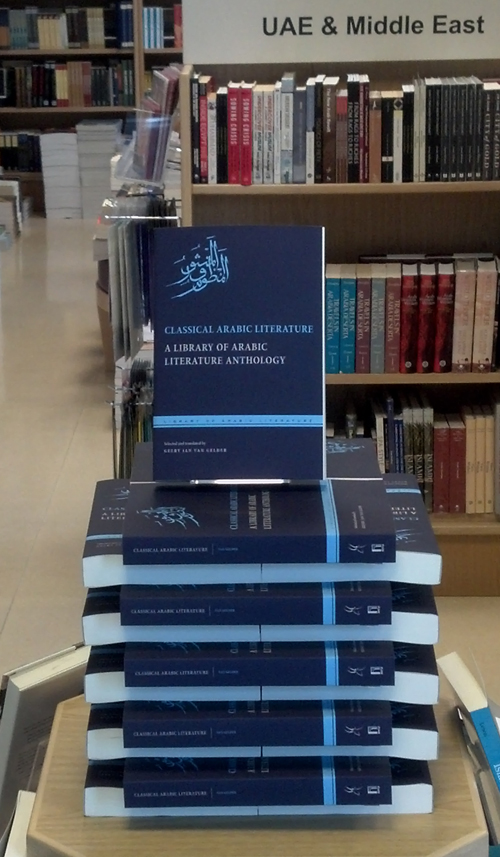Today we are introducing a new feature on the Library of Arabic Literature blog: interviews with our editor-translators conducted by M. Lynx Qualey, who runs the indispensable literary blog Arabic Literature (in English). We plan to run these interviews over the next few months, starting with her interview with our General Editor, Philip F. Kennedy.
Chip Rossetti
Managing Editor, Library of Arabic Literature
____________
Philip F. Kennedy, the Library of Arabic Literature’s General Editor, has been a key force in putting systems in place and getting the LAL — which focuses on Arabic-English editions of classical and pre-modern Arabic literature — on its feet. He spoke with M. Lynx Qualey at the 2013 Abu Dhabi International Book Fair about how the project came about, noting a few the challenges the editors and editor-translators have faced.
Can you really create a corpus of classical Arabic literature as a five-year project?
People think: “You must be crazy to think you’re going to do a comprehensive library of Arabic literature writ large, all the genres, all the way to the nahda. It would take two hundred years.” So, whatever! We just want to start. We decided we might as well start with things that haven’t been translated. With rare exceptions: Joe [Lowry] did the Risālah, which was already translated, in the early 60s. But on the whole, we’re trying to do things that haven’t been done. And that means choosing texts that are key texts, well-known texts, and other texts that even eighty percent of the people at AOS [the American Oriental Society] haven’t heard of.
This is not a canon, it’s a corpus. We’re getting away from the idea of canon. People will say, “Are you creating a canon?” And the answer is, “No.” There’s no question. The idea of a canon is just old-fashioned. It’s a form of intellectual imperialism.
We have some things we’d like to have done. We’d love someone to do Mutanabbi, but no one’s been foolhardy enough to come forward.
The key thing is to find a qualified person who’s willing to do the work. It’s no good just making a wish list if then no one will be able to take on the wish list. You need people to suggest books, ideally that haven’t been translated, that are generally part of the corpus of pre-modern Arabic literature.
And at the end of five years, you’re going to have 35 books?
Thirty-five volumes. Actual books.
You put thirty-five books on a shelf, and I think they can start to be persuasive. I have this very physical sense of it — that there’s a kind of gravity of the physical books, as a growing corpus, which can affect people’s attitudes toward the project, can attract attention to the project, and then the whole thing can grow. I think it’s important for people to see these books around and about. It creates a sort of prise de conscience: the discourse exists.
It might take a person twenty sightings of the books on the shelf before they actually pick one up. You read a paragraph, but that’s a part of a process of growth. And obviously there will be e-books, and that’s very important, and there is a digital aspect to this. We want to put things online, on the website, maybe critical apparatus can go online, so that the books are not weighed down by critical apparatuses. You can put stuff online that are addenda. And we want to make a searchable corpus, that’s important. That requires us to collaborate with other entities, other projects that have already digitized parts of the corpus. There’s a lot of collaboration that needs to be done yet, conversations to be had with people with analogous projects.
So, how did this all begin? How did you get involved?
I’ve always felt, as long as I’ve studied Arabic, that there’s a situation where the texts available in translation are very messy. And I expect I noticed that as a student, but then you get used to it. From time to time you come back and you ask yourself: “Well, why is this available, and why is that not available?” And you’d find some old fascicles of the Journal of Asiatic Studies and you’d stumble across some installment of a translation and you’d say, “Oh, there’s that here.” I became aware really early that there is stuff, and it’s all over the place.
Then when I came to work with NYU Abu Dhabi, part of the reason I got involved was because there was this possibility of applying for a grant to do this kind of thing. There are other [classical and pre-modern Arabic translation] projects, but they’re limited in scope. They just don’t have the resources that you need in order to do something comprehensive.
We sold it quite easily from the start as a translation project, but the idea that it be a parallel text translation project is something else. People agreed that’s what was needed, fortunately — preserve the Arabic and have the English. It seemed to me the project could do two things: make you discover the Arabic, as well as the English giving you access to the Arabic. Or, if you’re not an Arabic speaker, you’re able to read the English. So there’s this sort of multi-functionality about it.
How do you go about finding the right people?
Once we actually came to working on the project, and the rubber hit the road, it became apparent that the Arabic needs a lot of thinking about. It needs editing, and the editing is not as easy as that, because people don’t do it that much. Every scholar involved in one of these translations needs to be able to guarantee the text as a viable, credible Arabic text. You look through all the published editions, you look through the main manuscripts, and you produce a text that one can trust.
That varies enormously from genre to genre and text to text, but if the textual tradition is complicated, then the person doing it should be able to do it.
How do you find qualified editor-translators with the time to devote to this project?
[The editing] is not so easy, and it slows things down enormously. In some cases, it’s put people off. They’ve been willing to do a translation, but when they’ve been faced with what we’re really asking for, in terms of editing, and being familiar with the manuscript tradition, then they think twice, because there’s a time commitment.
That’s the other thing that stands in the way: It’s the fact that the academy in the West, in the States, doesn’t recognize this kind of work. And I think it should. You know, you have to produce monographs, and articles in peer-reviewed journals, but producing a critical edition or a credible edition of a translation counts for nothing, and I think that’s appalling. I think most of the people on the team think it’s appalling. It really is wrong.
Obviously it’s not going to change soon, but hopefully this can help change the way the kind of work we’re doing is evaluated for tenure purposes and promotion purposes, because that’s how people decide how they’re going to devote a semester of their time. “I’ve got a promotion coming up, so I can’t do this, because it doesn’t count.” For whom doesn’t it count? For the field it counts. So why are we doing what we do? Who are we working for?
So our hope is that if this has legs in ten years’ time, and we’ve really established what we wanted to establish, that this can help change the way that scholars in the field are evaluated.
What happens after the volumes are published?
We want this project to be part of a discourse.
Every work that’s come out could just hide on the shelf, but it would be nice to be able to showcase everything that comes out. Maybe not always in the same forum, but that’s why we do these discussion sessions. Now, we’re just introducing the project. But more and more, I hope we can get away from generalities of the project to actually looking at the particular work in question.
Joe Lowry’s given a great lecture when he first started translating the Risālah, explaining how his whole view of the Risālah has changed by doing the translation. He’s seen the whole structure of the work in a way that it’s not often seen.
That’s been the most interesting. Joe Lowry is one of the world’s great experts on al-Shafi’i, but in doing the translation, he came to see the work as a systematic overview of the structure of the divine law, and how the work is organized to that end.
What have been the most important elements you’ve gotten in place?
In terms of the structure, one of the important elements has been the creation of a handbook. It’s got all sorts of bits of advice and a whole glossary of suggested ways of translating certain common terms.
It’s an attempt to standardize, but we’re not forcing it down people’s throats. It also has some examples on ways one has tended to translate in the past using jargon and academese. We’d like the English to be good English and clear English and real English and twenty-first century English. One of the most important aspects of the modus operandi is that each editor-translator is paired with a project editor from among the board, who is a liaison between the editor-translator and the board, and is there as a sounding board, both on aspects of the editing and the translation.
So that introduces the idea of collaboration. So not only is there collaboration on the board, which does meet twice a year and meets over three days and has real work to do – we roll up our sleeves – but there’s collaboration between the board and the editor-translators.
It’s a loose style guide. There are a couple of examples of prose passages that one can recognize as something you might’ve read thirty years ago and how that’s not really acceptable any more. But I think we’re relying on the project editors to collaborate with the editor-translators to come up with something that’s acceptable and good.
What have been the most challenging sorts of translations?
With poetry, we have an issue. Poetry’s obviously extremely important, but it’s the most difficult thing to translate.
Last May when we met, after doing the business of reviewing what’s contracted and what stages those works were at, we decided to have a workshop on poetry. So we invited Peter Cole to come and talk to us about his views about the translation of medieval Hebrew and Arabic and translation in general. And it was a very useful, very practical, very hands-on workshop.
Some people say classical Arabic poetry is un-translatable?
Some people say that, but then you have to qualify that: because you either do it or you don’t. And we’ve decided you do it; you have to do it. But are you just producing a crib or are you producing an attempt at a poem? We could do both. There is a case to be made for doing both.
[When we had our workshop, there were] twelve people around the room. Robyn Creswell. Richard Sieburth, who’s a superb translator. Peter Cole. We listened to Peter, we listened to Richard, and there certain bullet points emerged that seem like very good practical advice. To what extent each individual can apply that advice when you actually do it is—well, that’s tricky. Some people are good at it, and some people are not.
Some people around the room were doing some really great work. We took a random poem and went line by line, around the room. And the idea was to have an overarching sense of what you want to do with this poem — basically an idea of what this poem is conveying to you emotionally, and also a formal stylistic idea of what you want to convey — and then stick to that. And it worked. Because around the room, every poem was consistent within itself.
And I did the worst one, because my idea was just to do the prose crib, so I just went line by line, and produced a block. Other people did these really lean poems. It was like haiku, which means you weren’t translating every detail of the poem, but conveying some essence. Successfully. Somehow, because we did it so methodically, it worked by steps, and the process was very enlightening. I think we decided that’s really the way to go.
**************************************************



